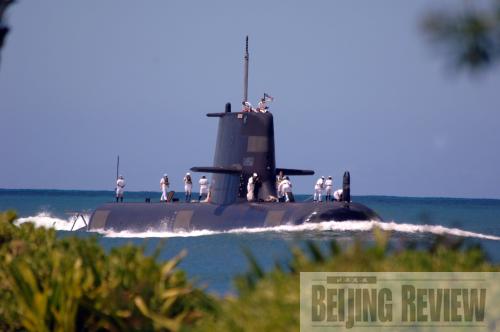|
 |
|
EMERGING FROM THE UNKNOWN: An Australian submarine approaches Pearl Harbor in Hawaii, the United States, on June 26, 2008. Australia participated in the U.S.-led multinational military exercises conducted in the name of "ensuring security of sea routes" and "jointly countering terrorism" (XINHUA/AFP) |
When Kevin Rudd ran for prime minister in 2007, he promised to issue a defense white paper as soon as possible, to address Australia's national interests in the new era. The white paper was originally scheduled to be released by the end of 2008, but it was delayed because of the financial crisis. Titled "Defending Australia in the Asia Pacific Century: Force 2030," the defense white paper issued on May 2 signals major changes in Australia's military goals and how it views its neighbors.
Enlarging military power
Compared with the last version former Prime Minister John Howard released in 2007, the Rudd administration's white paper has several differences.
First, Australia has returned its defense focus to the Asia-Pacific region. According to the 2007 white paper, Australia would pay more attention to the Middle East, because it had important strategic interests in the rocky region. The Rudd administration, by contrast, has mapped out a diplomatic blueprint for fully merging into Asia, as the world shifts its economic and strategic focus to Asia and the Pacific. The new white paper stresses that Australia has to increase its defense capabilities in the Asia-Pacific region in order to protect its interests. It also lists the changed situations. In recent years, developing countries such as China, India and Russia have asserted their presence in the region and begun to pose a challenge to the dominance of the United States. According to the white paper, the long-term presence of the United States has maintained regional peace and protected Australia's security in recent decades. But now, economic changes are disrupting the existing order and redistributing strategic power. The white paper points out that the financial crisis might accelerate the regional power shift, which could cause Australia's security situation to suddenly deteriorate. Global warming, fuel shortages and pressure on food and water resources are also emerging problems. As different countries try to guarantee supplies of these important resources, regional competition will intensify. Based on this, the white paper says that Australia must maintain a military that is prepared for war at any time, so as to safeguard the country's position in the world.
The new white paper is also alert to the threat of traditional war. The 2007 version believed that Australia did or would not face any regular military threat in the foreseeable future. Instead, it considered dealing with non-traditional security threats such as terrorism, proliferation of weapons of mass destruction and pandemic diseases to be its primary defense focus. But the new white paper says that although the possibility of military conflict between growing powers and the United States is small, it does exist. Therefore, Australia's root strategic interests are in maintaining its ability to respond to a direct military attack. The main duty of the Australian Defense Force remains waging traditional war against other military forces.
The white paper also lays out plans for defense spending that will cost more than 100 billion Australian dollars ($78 million) over the next 20 years, with a focus on protecting Australian borders. It suggests strengthening air and marine forces so as to protect the air and sea in the north, near oil and gas equipment. A purchasing package will double the current submarine fleet to 12 submarines, as well as add 100 F-35 fighters, eight frigates and three destroyers. Australia will also upgrade technologies related to satellites and the Internet and recruit 4,800 soldiers to beef up the current forces of 53,000. Rudd announced that the Australian Government plans to increase the general defense budget every year to guarantee enough funds. Until 2018, the defense budget will increase 3 percent every year. From 2018 to 2030, the budget will increase 2.2 percent every year. The Australian Defense Ministry needs to save 20 billion Australian dollars ($16 million) to buy new equipment.
China a military threat?The white paper was released at a time when Australians are sensitive about recent deals giving Chinese companies large stakes in Australian mineral resources. The opposition used the opportunity to attack the ruling party, accusing Rudd of being a "roving ambassador for the People's Republic of China," and rebuking the government for betraying the national interest by approving Chinese investment in Australia's mining sector. The Rudd administration is under great domestic pressure. The new white paper strikes back at accusations of Rudd's "pro-China" tendency by publicly listing China as a rival in an official document for the first time.
|
